What is a school?
A question in Dessau all too often answered in architectural terms. And while the space in which a school exists is not irrelevant, what is a school?
For the 2022 edition of the Stiftung Bauhaus Dessau's Bauhaus Lab the participants concerned themselves with education in apartheid era South Africa, considerations which took them far beyond the school room, and far beyond South Africa; and the results of which are presented in the exhibition Doors of Learning: Microcosms of a Future South Africa.......
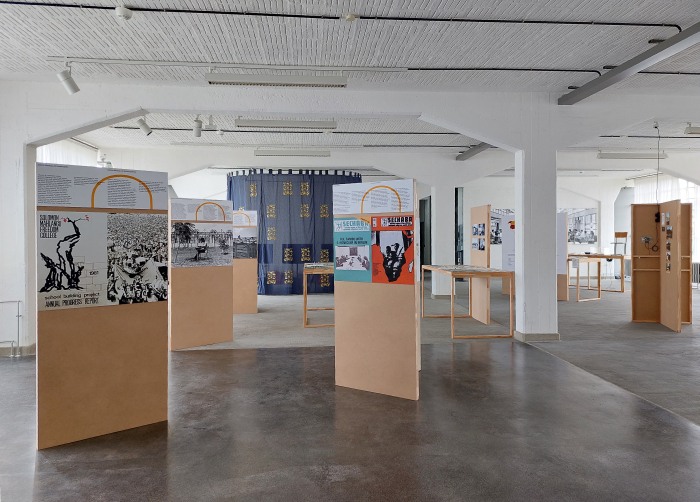
As a project Doors of Learning: Microcosms of a Future South Africa has its point of genesis in an international seminar staged in June 1987 in the Bauhaus Building Dessau, an international seminar staged in context of the United Nations Human Settlements Programme, a.k.a. UN Habitat's, designation of 1987 as International Year of Shelter for the Homeless, a year with, amongst other aims, the intention "to improve the shelter and neighbourhoods of some of the poor and disadvantaged by the end of 1987, particularly in the developing countries, according to national priorities, and to demonstrate by the year 2000 ways and means of improving the shelter and neighbourhoods of the poor and disadvantaged"1, a sadly ongoing pursuit; an international seminar staged under the English title: Solving the Housing Problem in the GDR - Its Relevance for the Developing Countries, a title which neatly explains the concept; and to that end a seminar attended by architects, urban planners and government officials from some 15 countries, predominately from Africa and Asia, in addition to representatives of two southern African resistance/independence movements.
As an exhibition Doors of Learning: Microcosms of a Future South Africa opens four decades earlier with the 1948 South African general election, a plebiscite (of sorts) which saw a coalition of the Herenigde Nasionale Party and the Afrikaner Party, two right wing Afrikaner Nationalist parties, form a government before merging in 1951 to establish the National Party, who would rule South Africa (as essentially an Afrikaner dictatorship) until 1994. In 1953 the National Party passed the so-called Bantu Education Act which strictly segregated education and (in effect) prescribed that black South Africans should only learn that which the white elite considered appropriate for their future place and role in society, or as the then Minister of Native Affairs H.F. Verwoerd opined in 1954 "the school must equip him [the Bantu pupil] to meet the demands which the economic life of South Africa will impose upon him ... The Bantu must be guided to serve his own community in all respects. There is no place for him in the European community above the level of certain forms of labour ... it is of no avail for him to receive a training which has as its aim absorption in the European community, where he cannot be absorbed".2 A 1953 education act which thus formed a cornerstone of South African apartheid, and resistance to which was a major component of the 1976 Soweto Uprising: an uprising led by black school pupils. An uprising of which black school pupils were the primary victims. An uprising whose 11th anniversary on June 16th 1987 was marked by a special session of the Dessau seminar.3
And an uprising, and for all a subsequent brutal repression, which led to an increase in the number of black South Africans fleeing to neighbouring countries; including a great many black South African school pupils and college students who post-Soweto left South Africa seeking a better education than that afforded them in South Africa. Among those nations that offered refuge for black South Africans was Tanzania, where in 1977 the African National Congress, ANC, that body established in 1912 to represent black South Africans, which was formally banned in 1960 and which played a leading role in organising and supporting refugees, was bequeathed by the Tanzanian government a former sisal farm in Mazimbu, some 200 kilometres west of the capital Dar es Salaam, and where a refugee community was established; a community that grew to incorporate a farm, a hospital, sports facilities, and a furniture factory, a community that grew to some 3,500 inhabitants, and a community very much centred around the so-called Solomon Mahlangu Freedom College, SOMAFCO, a secondary education institute named in honour of a member of the ANC's military wing Umkhonto we Sizwe who had been executed in South Africa following a contested murder conviction,4 and which through the broad education it offered formed an important component of the ANC's attempts to prepare for the post-Apartheid South Africa after which they strove.
And a flow of black South Africans to Tanzania, and to SOMAFCO, whose unabatedness throughout the late 1970s led to problems of space in Mazimbu and necessitated the construction of a second refugee community; a community established in the early 1980s some 55 kilometres north of Mazimbu, a community known as the Dakawa Development Centre, and which was envisaged to accommodate some 5,000 individuals in a conurbation of 10 semi-self contained villages grouped around an area with central services, but which ultimately "only" housed some 1,200 individuals.5
And refugee communities in Mazimbu and Dakawa that Doors of Learning employs as conduits in varied and various contexts.
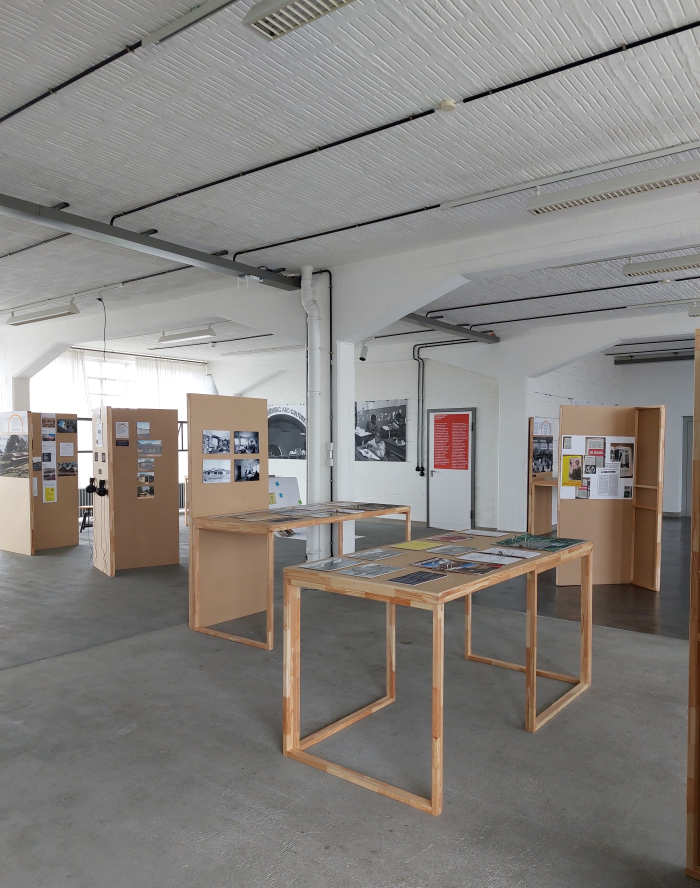
In comparison to the more artistic intervention of 2021's Bauhaus Lab Vegetation Under Power – Heat, Breath, Growth, Doors of Learning is much more a documentary presentation; a documentary presentation which allows direct insights in to Mazimbu and Dakawa, their contexts, their daily life, their various and varied roles and also their creation, including the physical creation, the physical construction. For all the physical construction of Dakawa.
Whereas the Mazimbu complex was largely constructed with local Tanzanian labour, albeit under the co-direction of the South African engineer Oswald Dennis, who had trained in East Germany where he had found refuge in the 1960s on account of persecution associated with his trades union activity in South Africa6, and also employing locally sourced materials and practices, the realities of the more remote and undeveloped site of Dakawa, and also the position of the ANC that South Africans should have a greater role in its construction, as a component of preparing for the much anticipated post-Apartheid society, led to the decision to employ relatively low-tech prefabricated systems for the construction of Dakawa. Low-tech prefabricated systems which on the one hand wouldn't require much in the way of infrastructure, of which there was none, and which on the other could be quickly learned and adopted by the largely technically unskilled South African emigrees who would undertake the construction.
Amongst the systems chosen by the ANC for the Dakawa Development Centre was a so-called Wall-Panel-Column, WPC, system developed by the Bauakademie in East Berlin.
Established in 1951 the DDR Bauakademie was that institution which had been at the forefront of the so-called Formalism Debate of the early 1950s, a political degradation and denunciation of Functionalist Modernist architecture and design, for all that architecture and design popularly associated with Bauhaus, accompanied by zealous support of a representative neoclassical interpretation of a (perceived) national style based on traditional methods and crafts. Before, following Stalin's death in March 1953 and the associated realisation that rather than laborious, slow, expensive construction what the fledgling DDR actually needed was, as the DDR's then First Secretary Walter "¿¿Wall??" Ulbricht phrased it in April 1954, "better, faster and cheaper construction"7, the Bauakademie became increasingly involved in the development of (semi-)industrial construction practices, for all the Plattenbau systems, the modular prefabricated concrete construction systems, which came to define construction in the DDR.
Plattenbau systems of which the WPC system employed in Dakawa can very much be considered a version of.
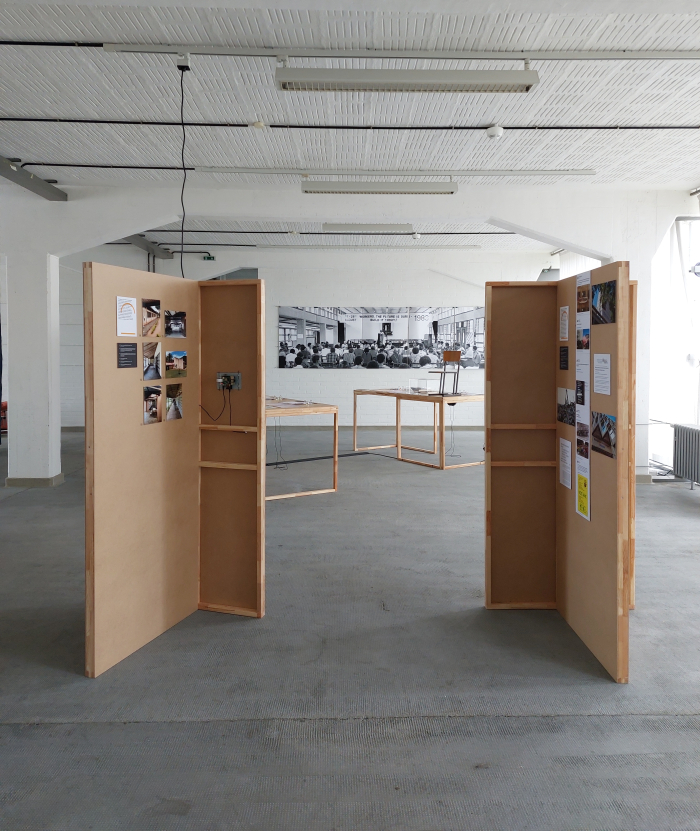
We can find only little information on the Bauakademie's WPC system, and as an exhibition Doors of Learning is also, regrettably, short on specifics; however, as best as we can ascertain, and we may be wrong, we often are, but as best we can ascertain, the WPC system was developed in context of a concerted effort by the DDR authorities in the 1980s to develop construction systems specifically intended for what they referred to as developing nations8, at that time the DDR being involved in projects in countries such as, and amongst others, Yemen, Algeria or Mozambique, i.e. predominately nations from the African and Asian continents who participated in the 1987 Dessau seminar which sought to extrapolate and adapt (and sell) the DDR's experiences, and systems, to the local realities of other nations, cultures and climates; but also, and standing quite incongruously amidst a range of left-leaning, Moscow focussed, developing, nations, a project for the Staatsfeind next door9. Yet while the vast majority of the housing types, and one gets very much the impression, and as with the DDR Plattenbau systems, of a typiserung in the approach, were substantial buildings, what are referred to as "medium-cost housing"10, the WPC system is described as being "solely for single-storey "low-income" residential, and simple social, buildings"11 i.e. the sort of buildings that one may seek to quickly construct for displaced peoples where permanent solutions aren't anticipated. Something tended to be underscored by it possessing a maximum load capacity of just 0.2 tonnes, i.e. 200 kilogrammes. i.e. nothing.
A system for simple purposes appropriately simple in practice: a skeletal system in which a variety of preformed concrete elements were slotted in to, supported by, vertical concrete columns. And thus a system perfectly suited to meet the demands of the ANC for Dakawa; albeit a simple skeletal system employed to construct just two nurseries, the promises of a much more widespread utilisation never being realised.12
And a simple prefabricated (semi-)industrial construction system developed by the DDR Bauakademie which links very nicely back to the Bauhaus the DDR Bauakademie once sought to vilify; or more accurately links very nicely to numerous Bauhäusler who post-Bauhaus developed ideas on construction began at Bauhaus in to modular, prefabricated, building systems, to enable (semi-)industrial construction, including, amongst many others, Walter Gropius, Franz Ehrlich or Carl Fieger, the latter who in 1952 took up a position at the DDR Bauakademie and played a key role in the practical realisation of the first Plattenbau systems in the DDR, and that at the height of the Formalism Debate. Which tends to underscore the regular discrepancy between words and deeds in context of East German politics. And tends to underscore how ideas developed at Bauhaus evolved post-War. And a Carl Fieger who would undoubtedly have contributed a lot more to the development of modular, prefabricated construction in the DDR had a stroke in 1953 not cruelly forced him into an early retirement.
Thoughts of Bauhaus which remind that beyond considering the physical spaces the defined Mazimbu and Dakawa, and the various and varied ways the international community helped develop them, Doors of Learning primary focus is education.
Schools.
But what is a school?
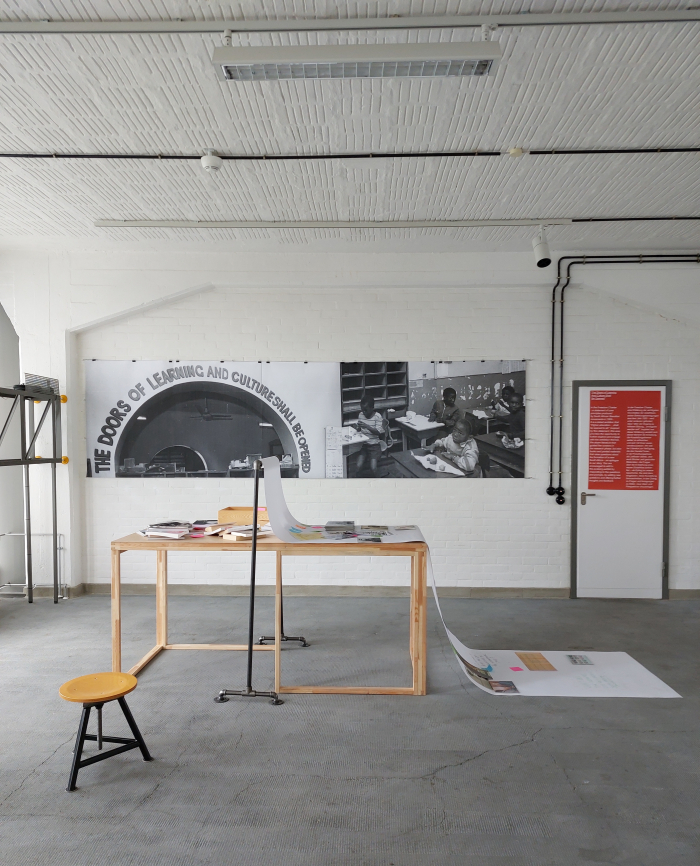
In the course of the 16 minute film which plays on constant loop in Doors of Learning there is a presentation of the pedagogical position on which the school was based, which set its aims, and which defined how the teachers were to proceed and relate to the pupils, and which notes that "in the primary division ... we are laying the real foundations of our future society". A statement which does little more than confirm what all education is concerned with, and in doing so confirms that it is something we all tacitly accept yet only rarely question.
Even though we obviously all should.
The schools in Mazimbu and Dakawa, primarily SOMAFCO, were established as a response to a skewed and corrupt education system, one which sought to develop a future society in which part of the population was denied the chance to fully develop and express their possibilities and potential, an education system that, if one so will, sought to perpetuate colonialism in South Africa. Yet while SOMAFCO taught the maths, sciences and languages that weren't, or at least not so readily, freely and universally, taught to black South Africans in South Africa, the SOMAFCO curriculum was also heavily politicised, or as Brown Bavusile Maaba opines included "overtly ideological courses intended to orient pupils towards ANC views of the world", for all, according to Maaba, the courses Development of Societies and History of the Struggle, the former being a "Soviet-style analysis of world history", the latter "openly intended to indoctrinate students with ANC ideology".13 And while it is relatively easy to feel sympathy for and support any struggle against an unjust political and economic system, particularly one as abhorrent as South African apartheid, how far can and should an education system go in advancing the political side of the struggle? And in countries not as ostensibly involved in an internal civil conflict and battle for direction as South Africa was, what is the purpose and function of education? Does it vary or is it essentially always the same?
Thoughts which, as you stand in the Bauhaus Building Dessau, lead you to reflect on both the 1970s/80s curriculum in SOMAFCO and the 1970s/80s curriculum at the Erweiterte Oberschule, the state secondary school, in Dessau. And the similarities between the two. And the differences. For all the contextual and conceptual differences. The differing whys. The content may have regularly overlapped, the whys only rarely. And also to reflect on the future society, future country, both were intended to develop. Future countries which, in both cases, unexpectedly began to take on a radically new form in 1989: the future South Africa beginning to move towards the post-Apartheid society the ANC strove for, the future East Germany beginning to move towards its dissolution. And how did the curriculum at SOMAFCO and the Erweiterte Oberschule Dessau assist those new societies? In terms of the latter, that's a question for another day; in terms of the former, as Doors of Learning discusses the impact of SOMAFCO ultimately wasn't that great, SOMAFCO having only little influence on South Africa. Or at least not at a macro scale, at a micro scale, for the individual students, it invariably had a much larger and more meaningful influence and effect. And a lack of notable effect at the macro level that is in itself interesting.
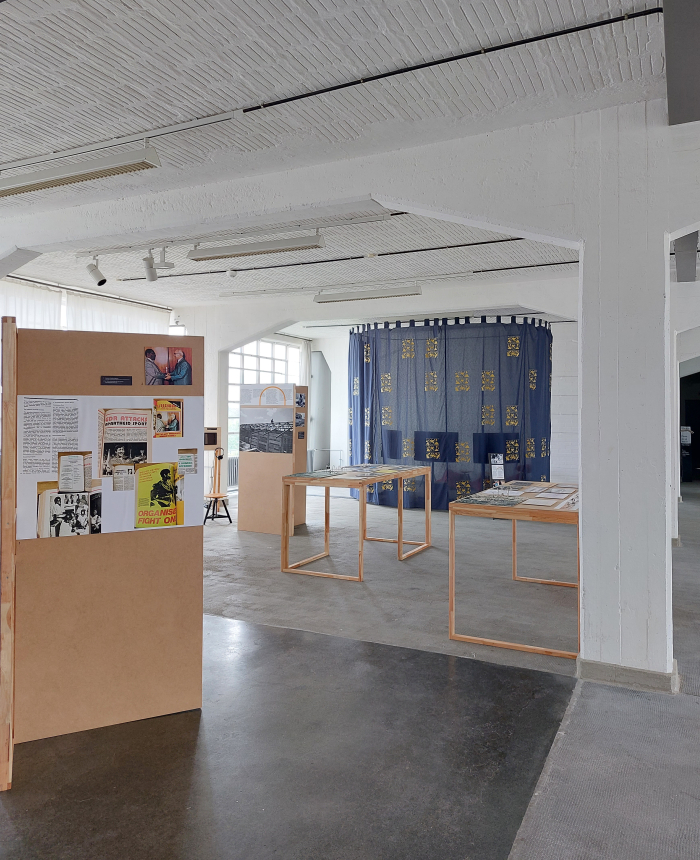
Thoughts on SOMAFCO, as you stand in the Bauhaus Building Dessau, which also leads one to reflect on Bauhaus, a school, two schools, teaching for a future country, a future society, schools that, as with SOMAFCO, are today popularly celebrated as institutions in context of the prevailing realities in which they arose and functioned, and are unquestionably significant and important moments in explaining and understanding an ongoing path, but schools in Weimar and Dessau which weren't necessarily neutral in their conception and positions: the early Weimar Bauhaus, for example, was under a not unimportant, not insignificant, influence of Mazdaznan, an esoteric cult with ideas of race not that far removed from those of the South African National Party, and who certainly wouldn't be allowed anywhere near a state funded school in the contemporary Germany, and a Mazdaznan influence on Bauhaus Weimar all too often ignored in the popular Bauhaus (hi)story, one of a great many uncomfortable associations regularly obscured by whitewashed walls. While at Bauhaus Dessau, Hannes Meyer's Volksbedarf statt Luxusbedarf , [The needs of the masses not of provision of luxury], was very clearly a political statement, a very clear challenge to existing political and economic orders, as was his move to a collectivisation of the design process, his replacement of the autocratic Meister with the democratic consensus, even if a large part of Dessau's commercial income came from luxurious wallpapers. And they still had Meister. ¿But the sort of position a school should take? ¿For all the sympathy one may have for the position, is it one a school should hold and work towards?¿Or should a school empower pupils to define their own relationships to society and the provision of objects of daily use?
And while, and much as not everyone at SOMAFCO were interested in the ANC's dogma15, not everyone at Bauhaus Weimar was an adherent of Mazdaznan, nor all at Bauhaus Dessau proponents of Meyer's politics, such moments do allow for easy access to reflection and consideration on the Bauhaus schools as attempts to develop a very particular future society, a particular future country, rather than to develop citizens of a future society, a future country. ¿And SOMAFCO? ¿How did it envisage the future post-Apartheid South African? ¿And could that be why its influence on contemporary South Africa is limited?
Thoughts on SOMAFCO, DDR, Bauhaus and apartheid era South Africa which are extremely contemporary: one thinks, for example, of eduction in those areas of Ukraine currently occupied by Russia, and where the curriculum will invariably be, is, employed to reinforce the position of the occupier, to reinforce the validity, the necessity, of the invasion and thereby attempt to keep future resistance in check by seeking to deny coming generations access to the information and knowledge they would need to resist. ¿And what are the alternatives? Or of those myriad schools around the world whose curriculum is based on a fundamental, dogmatic interpretation of religion of all types, and which places that religion at the centre of society. ¿And what are the alternatives?
And thoughts on SOMAFCO, DDR, Bauhaus and apartheid era South Africa which help elucidate that education is not just learning your ABC, and never was and never will be; that education is a tool for designing society, and that as with all design tools, as with all design, and all architecture, can be used for both positive and nefarious purposes. And can be used well or can be used ineffectually. Which is why we all need to be aware of what is being taught and why, to question eduction systems.
To ask, as a Tom Paxton does, What Did You Learn in School Today? or, and staying very much in context of attempts to break colonial power structures and influences in Africa, to repeat Fela Anikulapo Kuti's demand, Teacher Don't Teach Me Nonsense.
Doors of Learning very neatly, and pleasingly, nudges you towards that questioning.
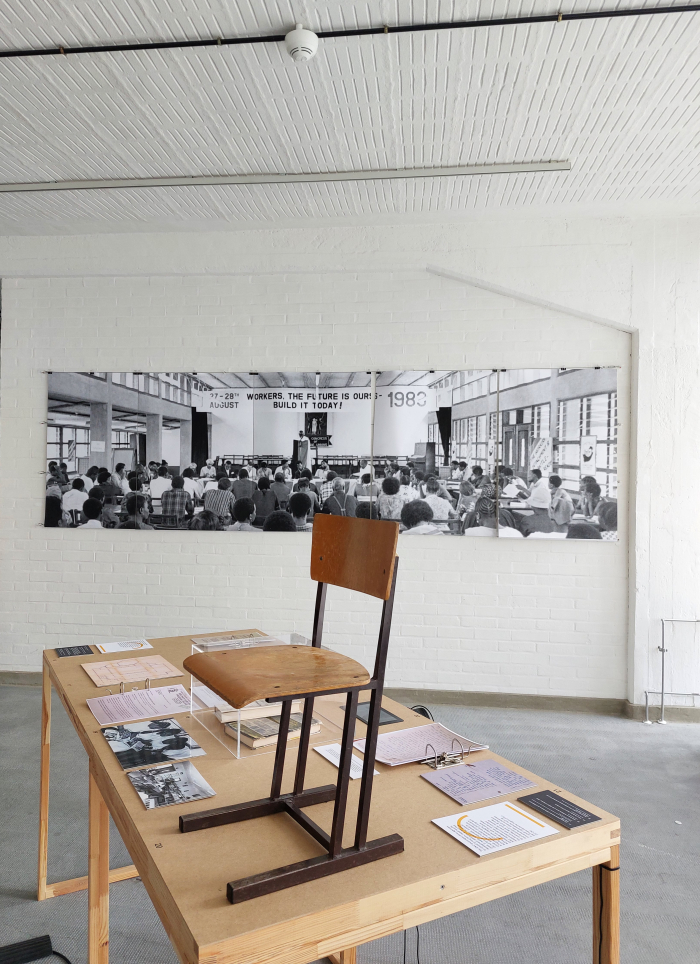
Making goodly use of photos, archive documents and objects, and also innumerable video interviews with those involved in the various stages and contexts of the Mazimbu and Dakawa communities, video interviews which help expand and deepen that presented, Doors of Learning is a readily approachable, comprehensible and nicely paced exhibition, which, as with other Bauhaus Lab exhibitions, isn't so much a place to find answers as a place which to ask questions, an opportunity to better formulate questions, and thus more a point of departure on new journeys than a destination in itself. Is, if one so will, a door to learning.
A door to learning which not only provides for a wide-ranging introducing to the South African communities at Mazimbu and Dakawa, an introduction which allows for some very timeous reflections on refugees, the needs of refugees beyond food and shelter, of supporting refugees as a component of tackling the problems in their homelands, and thereby, hopefully, improving global society, and also the relationships between refugees and the host nation/population: but also invites one, demands one, (re)acquaint oneself with apartheid in South Africa, to reflect on the ongoing relevance of that period in global (hi)story, to question what as a global society we've learned from apartheid, what we still need to learn, and where is South Africa today? And why?
A door to learning which provides access to some alternative perspectives on East Germany, for all East Germany as a global nation, of East Germany as commercial nation seeking its place and influence in global economic systems, of the Cold War as not always being as icy as it is often presented, of their being warmth in the European chill; and also enables a critical questioning of the hows, whys and wherefores of international aid, of who is making decisions, on what basis, and in whose interests. A critical questioning of international aid in the 1970s, 1980s and today, and for all a critical questioning of what we can learn from the (hi)stories of Mazimbu and Dakawa with the benefit of 40 years distance.
And a door to learning which is an interesting, informative and entertaining manner in which to approach and view Bauhaus, the various and varied links between Mazimbu and Dakawa, the many paths that can be traced from Weimar and Dessau over Mazimbu and Dakawa to today, and the differentiated perspectives and insights of Bauhaus they enable, helping move understandings and appreciations of Bauhaus away from the 1920s and 1930s and on to the 2020 and 2030s. Which is important, especially when wandering through the fabled and objectified spaces of Gropius's Dessau Bauhaus Building, because if there was one thing Bauhaus wasn't about it was the past. And if there is one thing Bauhaus shouldn't be today, it is then.
But for all Doors of Learning challenges you to reflect on what education is, can be and should be. To question what is a school: conceptually, socially, culturally, politically, pedagogically..... And, yes, physically.
Doors of Learning. Microcosms of a Future South Africa is scheduled to run at the Bauhaus Building, Gropiusallee 38, 06846 Dessau-Roßlau until Sunday January 8th
Full information, including information on opening times, ticket prices and current hygiene rules can be found at www.bauhaus-dessau.de
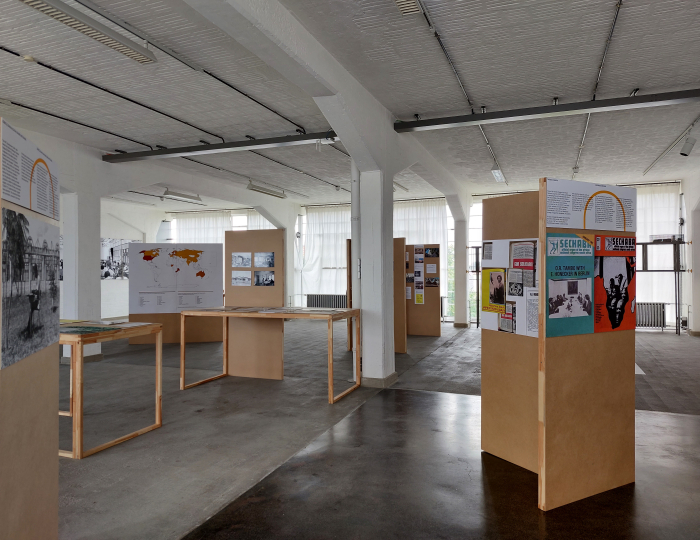
1Resolution adopted by the General Assembly, 37/221. International Year of Shelter for the Homeless, 20.12.1982 available via http://www.un-documents.net/a37r221.htm (accessed 10.10.2022)
2H.F. Verwoerd, Bantu Education: Policy for the Immediate Future - Statement by the Hon. Dr. H. F. Verwoerd, Minister of Native Affairs in the Senate of the Parliament of the Union of South Africa, reprinted in Nancy L. Clark and William H. Worger, South Africa. The rise and fall of apartheid, Routledge, 2016 It needn't be added that Verwoerd's use of "Bantu" to describe black South Africans is not irrelevant.......
3Gedenkmeeting für Soweto-Aufstand. Seminar zum UNO-Jahr im Bauhaus Dessau, Neue Zeit, 17.06.1987, page 2/B
4Solomon Mahlangu and two colleagues were preparing for a self-initiated, i.e not formally sanctioned and planned, attack in Johannesburg when they were discovered with guns and explosives. In their attempt to flee the police Mahlangu and Monty Motaung took refuge in warehouse in Goch Street where a gun fight subsequently ensued in which two civilians were killed. On their arrest Mahlangu and Motaung were beaten by the police, Motaung so severely that he suffered brain damage and was unable to stand trial. Mahlangu was tried, found guilty and executed. Post-apartheid the Truth and Reconciliation Commission considered Mahlangu's case and decided that while the action may have been part of the ongoing armed struggle "such unplanned operations often resulted in the perpetration of gross violations of human rights in that they caused civilian loss of life and injuries", and thus tended towards confirming Mahlangu's guilt, certainly making him responsible for the deaths. If the death penalty was based in law or racism is however another question. see Truth and Reconciliation Commission of South Africa Report, Volume Two available via https://www.justice.gov.za/trc/report/finalreport/Volume%202.pdf (accessed 10.10.2022)
5see Seán Morrow, Dakawa Development Centre: An African National Congress Settlement in Tanzania,1982-1992, African Affairs, Vol. 97, No 389, October 1998
6Alongside Oswald Dennis the other key figures were in the physical development of Mazimbu were the British?, Canadian?, architect Spenser (sometimes Spencer) Hodgson who appears to have (at least partially) studied in Weimar during the DDR epoch, and the Danish architect and aid volunteer Lars Nordbo
7Quoted in Andreas Schätzke, Zwischen Bauhaus und Stalinallee: Architekturdiskussion im östlichen Deutschland 1945 – 1955, Vieweg Verlag, Braunschweig, 1991 In December 1954 Stalin's successor Nikita Khrushchev spoke of the need for "Better, cheaper and faster construction", which proves the DDR didn't simply follow the USSR, sometimes they changed the order of the words.......
8see Bauakademie der DDR, F/E - Staatsplanaufgabe ZF 11.01 "Massenwohnungsbau in Nationalstaaten, 30.03. 1984 available via https://bauarchivddr.bbr-server.de/bauarchivddr/archiv/plarchiv/00563-4598/akten-und-mappen-pdf/00563-4598-massenwohnungsbau.pdf PDF!!! & Bauakademie der DDR, Wohnungsbau in Entwicklungsländern, Thema ZF 11.01. 18684F/E - Bericht Zur Arteitsstufe A2, Febr. 1985 available via https://bauarchivddr.bbr-server.de/bauarchivddr/archiv/plarchiv/00432-4179/akten-und-mappen-pdf/00432-4179-wb-entwicklungslaender.pdf PDF!!! (accessed 10.10.2022)
9ibid, page 5 states that between 1980 and 1984 one house building tender was made for West Germany, while at https://bauarchivddr.bbr-server.de/bauarchivddr/archiv/plarchiv/02928-4653/akten-und-mappen-pdf/022928-4653-gutachten-tauwasserschutz.pdf PDF!!! (accessed 10.10.2022) one finds an expert report and recommendations concerning problems with missing condensation protection on three houses built by VEB Fertighausbau Neuruppin in an unnamed location in West Germany.... That's all we know. For now.....
10Bauakademie der DDR, Wohnungsbau in Entwicklungsländern, Thema ZF 11.01. 18684F/E - Bericht Zur Arteitsstufe A2, Febr. 1985 page 3 available via https://bauarchivddr.bbr-server.de/bauarchivddr/archiv/plarchiv/00432-4179/akten-und-mappen-pdf/00432-4179-wb-entwicklungslaender.pdf PDF!!! (accessed 10.10.2022)
11We're assuming it is the here described system, btu it might not be, as we say information is hard to come by: Bauakademie der DDR, Pflichtenheft zum F/E-Staatsplanthema "Massenwohnungsbau für Nationalstaaten" ZF 11.01, 30.03.1984 page 8 available via https://bauarchivddr.bbr-server.de/bauarchivddr/archiv/plarchiv/00553-4588/akten-und-mappen-pdf/00553-4588-pflichtenheft.pdf (accessed 10.10.2022)
12see Peter Wurbs, Aufbau des ANC-Entwicklungszentrums Dakawa in Tansania, Architektur der DDR No. 9, 1989 That more wasn't constructed with the WPC invariably has several reasons whereby the demise of the DDR unquestionably played a role. The nurseries were constructed between October 1987 and February 1988......
13Brown Bavusile Maaba, Alternative Schooling for South Africans: Notes on the Solomon Mahlangu Freedom College in Tanzania, 1978-1992, The International Journal of African Historical Studies, Vol. 37, No. 2, 2004
14see ibid